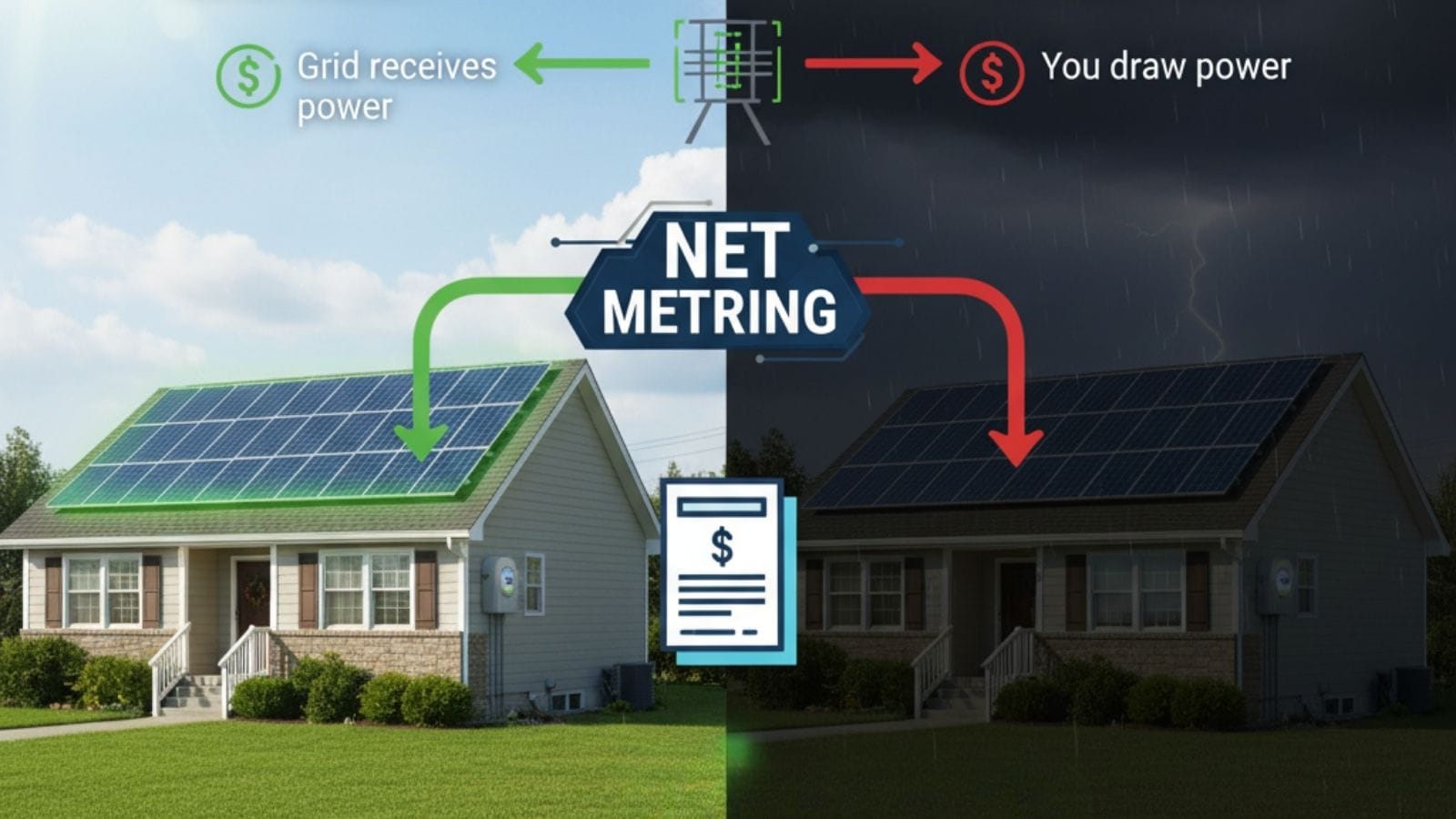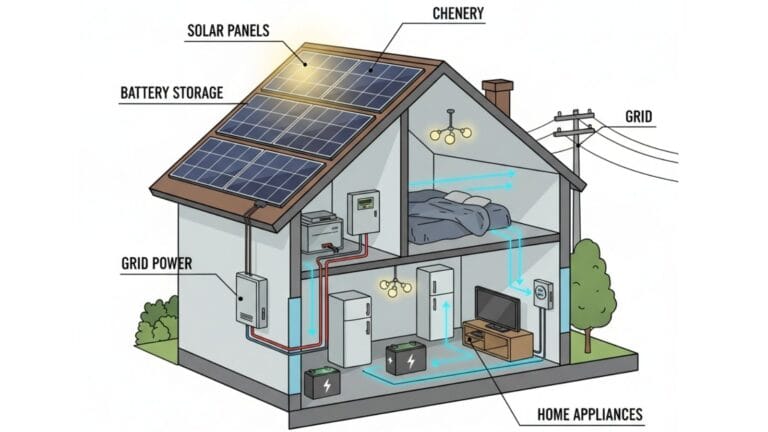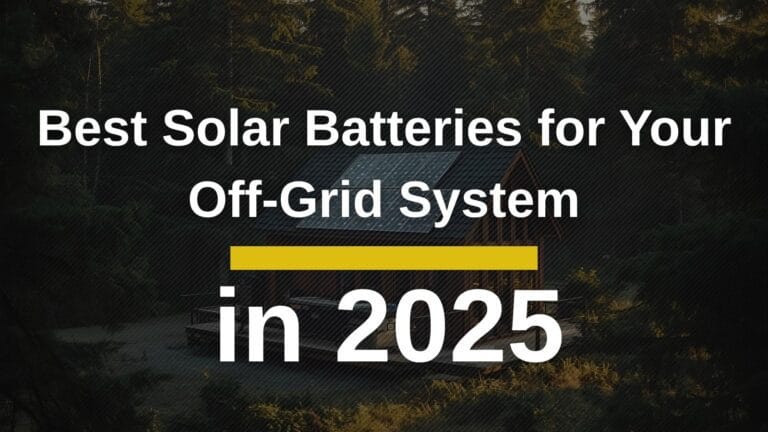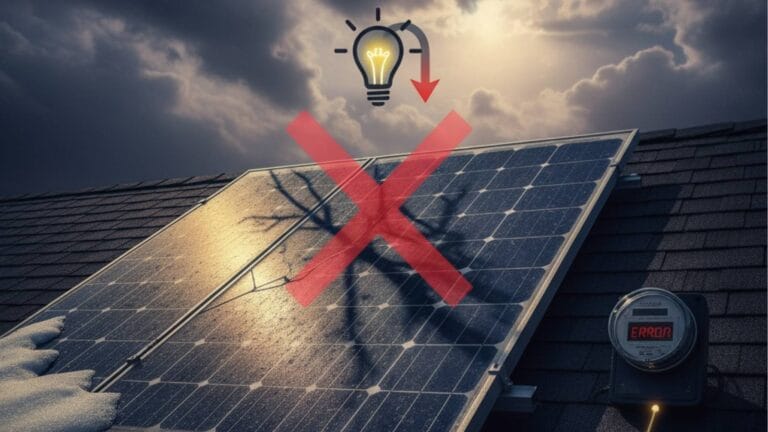Decoding Net Metering: How Your Solar Panels Interact with Your Electric Bill
Installing solar panels is a powerful step towards energy independence and lower electricity costs. But have you ever wondered what actually happens when your panels produce more power than your home is using? Where does that excess energy go, and how do you get credit for it? The answer to these crucial questions lies in a policy called net metering.
Understanding how net metering works is fundamental to understanding the financial return of your solar investment. It’s the mechanism that turns the utility grid into a giant, shared battery for your solar energy, directly impacting your monthly savings. This guide will decode the entire process, from the simple analogies to the nitty-gritty of your electric bill, and explore the future of this game-changing solar policy.
What is Net Metering? The Simple “Energy Bank Account” Analogy
The easiest way to understand net metering is to think of the utility grid as your personal energy bank account.
- Deposits: When your solar panels produce more electricity than you need, you “deposit” that excess energy into the grid for others to use.
- Withdrawals: At night, or on a cloudy day when your panels aren’t producing, you “withdraw” energy from the grid to power your home.
Net metering is simply the billing system that keeps track of these deposits and withdrawals. At the end of the month, your utility looks at your “net” energy usage—the difference between what you withdrew from the grid and what you deposited. You only pay for the difference. If you deposited more than you withdrew, you often receive a credit for the surplus.
Understanding net metering is fundamental to understanding the financial return, which you can estimate with our solar panel ROI calculator.
How Net Metering Works: A Day in the Life of a Solar Home
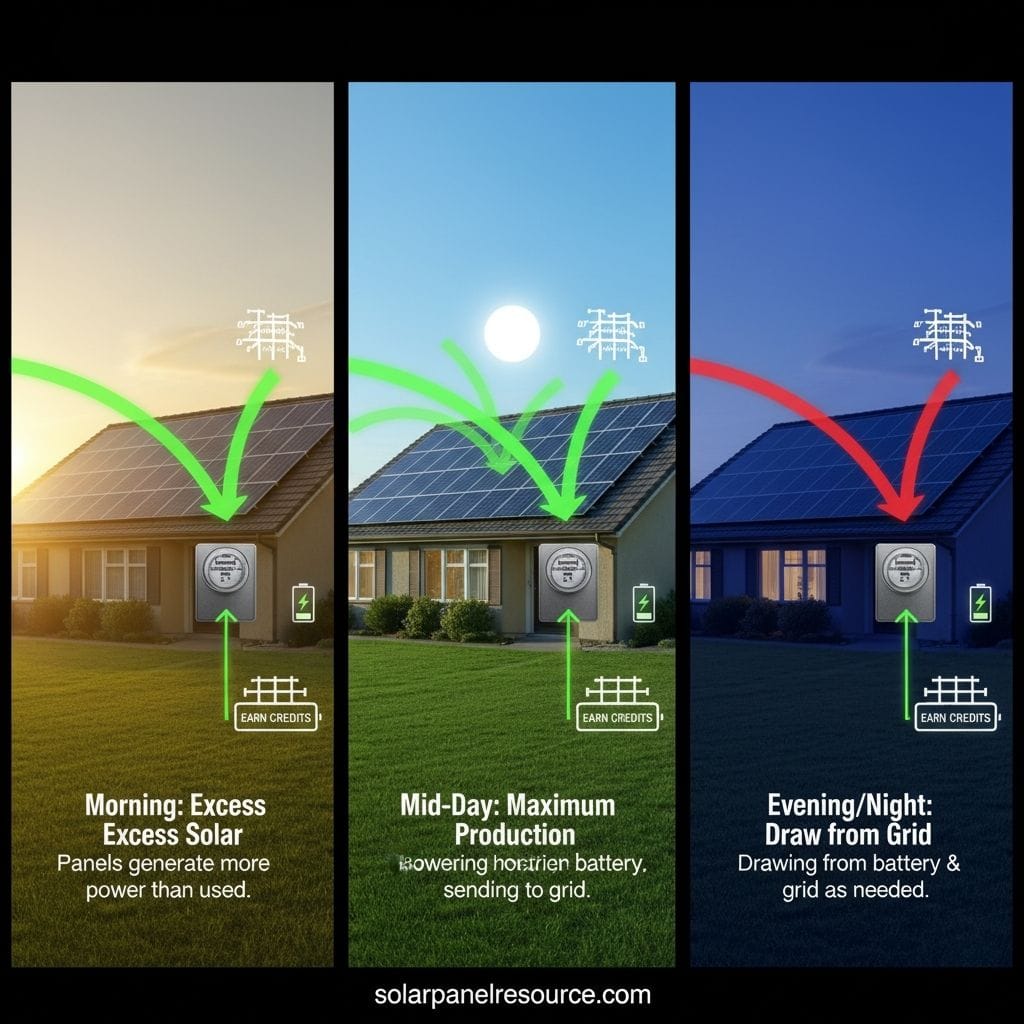
To see the concept in action, let’s walk through a typical sunny day for a home with solar panels and a net metering policy.
Morning (7 AM – 10 AM): Low Production, High Consumption
The sun is up, but it’s low in the sky, so your panels are producing a small amount of power. Meanwhile, your family is getting ready for the day—the coffee maker is on, you’re using lights, and the toaster is running. During this time, your home’s energy demand is higher than your solar production, so you are still pulling some power from the grid to cover the shortfall.
Midday (10 AM – 4 PM): High Production, Low Consumption (Earning Credits)
This is peak solar time. The sun is high overhead, and your panels are generating a large amount of electricity. You might be at work or school, so your home’s energy consumption is low. Now, the magic happens: you are producing far more power than you need. This valuable excess energy flows out of your home and onto the grid. For every kilowatt-hour (kWh) you export, you earn a net metering credit in your “energy bank account.”
Evening (4 PM onwards): No Production, High Consumption (Using Credits)
As the sun sets, your solar panels stop producing power. At the same time, your evening energy usage ramps up as you cook dinner, watch TV, and turn on the lights. Now, you begin withdrawing electricity from the grid. However, instead of paying for all this energy, you start drawing down the credits you “banked” during the middle of the day. Thanks to net metering, the energy you use at night is effectively offset by the energy you produced that afternoon.
The Key Component: Understanding Your Bi-Directional Meter
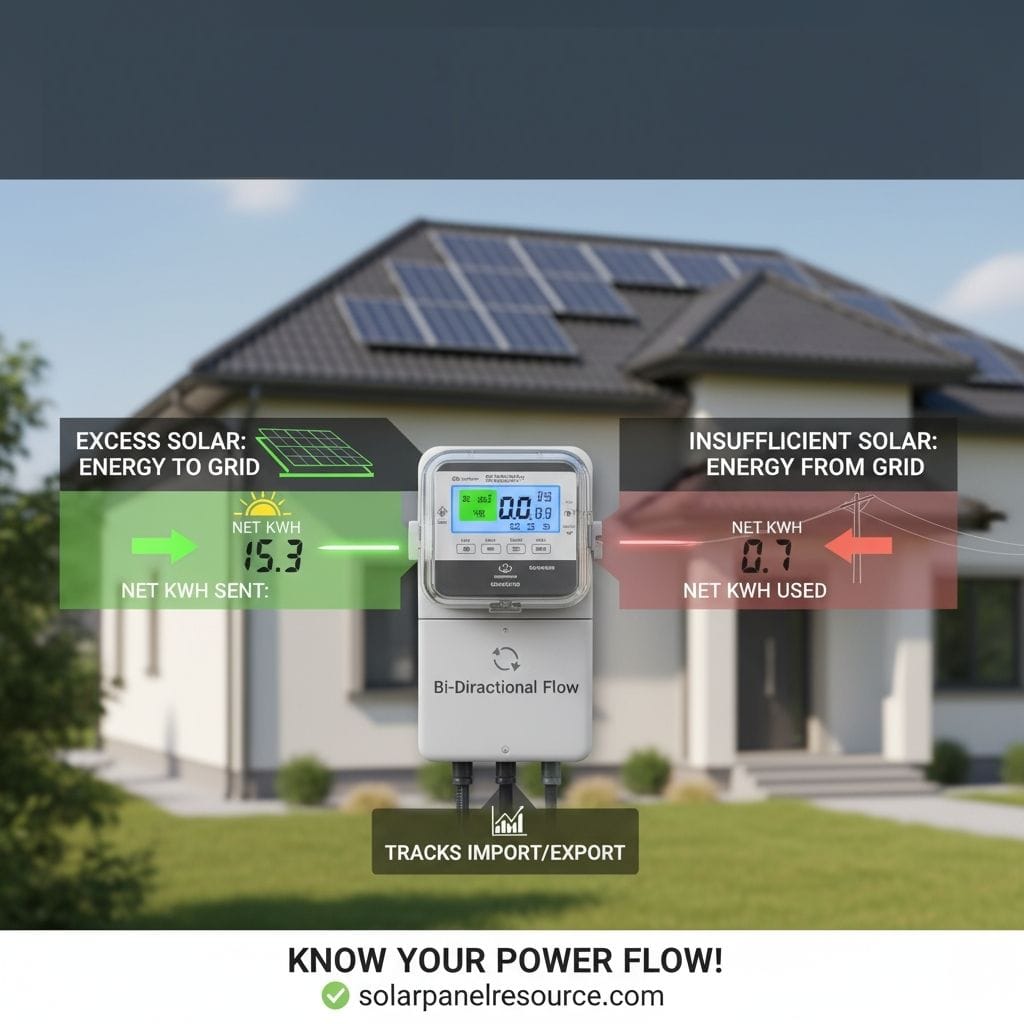
This entire process is made possible by a special piece of equipment called a bi-directional meter. After you install solar panels, your utility company will typically replace your old, one-way meter with one of these.
Unlike a traditional meter that only measures the electricity you *consume* (in one direction), a bi-directional meter measures energy flowing in two directions:
- The electricity you pull **from** the grid.
- The excess solar electricity you send **to** the grid.
This device is what allows the utility to accurately track your “deposits” and “withdrawals” and calculate your net usage for billing.
Reading Your Electric Bill with Net Metering: A Breakdown
Your new solar panels electric bill will look a bit different. Here are the key lines to understand:
- kWh Delivered: This is the total electricity your utility delivered *to you* from the grid (your “withdrawals”).
- kWh Received: This is the total excess solar electricity you sent *to the utility* (your “deposits”).
- Net Energy Usage: This is the simple calculation: (kWh Delivered) – (kWh Received). This is the amount of energy you will be billed for. If the number is negative, you have a credit.
Many bills will also show a “bank” of your accumulated net metering credits. These often roll over from month to month. This is particularly useful for seasonal variations—you can build up large credits during long summer days and use them to offset your higher energy usage during the winter.
The Different Flavors of Net Metering Policies
Not all net metering policies are created equal. The value of your solar credits depends entirely on the rules set by your state and utility. According to the U.S. Energy Information Administration, policies can vary significantly.
1:1 Retail Rate Net Metering: The Gold Standard
This is the most favorable type of policy for solar owners. In a 1:1 system, the credit you receive for the energy you export is worth the exact same “retail” price that you pay for energy you import. If you pay €0.25 per kWh, you get a credit of €0.25 for every kWh you send to the grid.
Net Billing & Avoided-Cost Rate Policies
In these systems, the value of your exported energy is lower than the retail rate. The utility might credit you at the “avoided-cost” or “wholesale” rate, which is the price they would have paid to get that energy from another source, like a power plant. This is typically much lower than the retail price, which reduces the overall value of going solar.
The Great Debate: Why is Net Metering Controversial?
Net metering is incredibly popular with consumers, but it’s often a point of contention for utility companies and has sparked intense policy debates. Understanding both sides is key.
The Utility Perspective: Grid Costs and Maintenance
Utilities argue that even if a solar customer has a net usage of zero, they still rely on the grid’s infrastructure (poles, wires, transformers) 24/7. They contend that retail rate net metering doesn’t allow them to collect enough revenue from solar customers to cover the costs of maintaining that grid, forcing them to shift those costs to non-solar customers.
The Solar Owner Perspective: Fair Compensation for Clean Energy
Solar advocates argue that homeowners are providing clean, valuable energy to the grid precisely when it’s needed most (on hot, sunny afternoons), reducing strain on the system and avoiding the need for utilities to build expensive new power plants. They believe that compensating this energy at the full retail rate is fair value for the benefits provided.
The Future of Net Metering: Trends to Watch in 2025 and Beyond
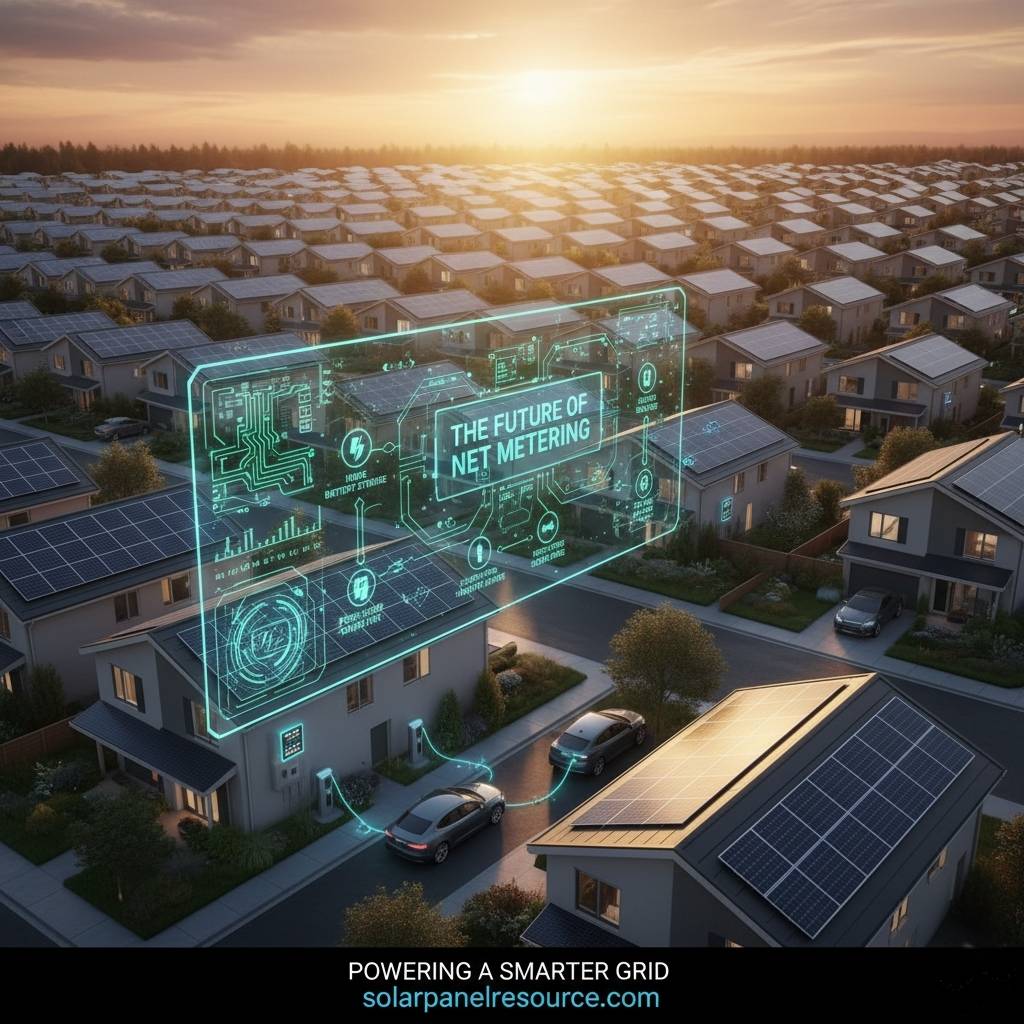
The policy landscape is evolving. As more solar comes online, many regions are updating their net metering rules.
This policy shift creates a much stronger financial incentive to store your own excess energy, which you can learn about in our ultimate guide to how solar batteries work.
The Shift Towards “Net Billing”
The most significant trend is the move away from 1:1 retail rate net metering towards “net billing” or “avoided cost” models. A high-profile example is California’s NEM 3.0 policy, which significantly reduced the export credit rate. This makes the immediate financial return on solar lower than it was previously.
The Rise of Solar Batteries and Self-Consumption
As export rates decrease in value, there is a much stronger financial incentive to store your own excess solar energy in a battery. By doing so, you can use your own stored solar power at night instead of exporting it for a low credit and then buying it back at the high retail rate. This strategy is known as self-consumption.
Do net metering credits expire?
This depends entirely on your local utility’s policy. In many places, credits roll over indefinitely. In others, they may expire or be cashed out at a lower rate at the end of a 12-month period. It’s crucial to check your specific utility’s rules.
What is the difference between net metering and a feed-in tariff (FiT)?
Net metering is a billing mechanism that offsets your consumption. A Feed-in Tariff is a direct payment scheme where you are paid a set rate for all the solar energy you produce, regardless of whether you use it yourself or export it. FiTs are more common in Europe, while net metering has been the dominant model in the United States.
What happens if I move? Do I get to keep my credits?
No. Net metering credits are tied to the meter and the account at that specific property. The credits would typically be transferred to the new homeowner or zeroed out by the utility upon closing the account.

Solar Energy Enthusiast & Renewable Energy Researcher
Vural’s journey into solar energy began four years ago, driven by frequent power outages and high electricity bills at his own home. He has since gained hands-on experience with both personal and commercial solar projects. At solarpanelresource.com, Vural shares his real-world insights and in-depth research to guide homeowners and business owners on their own path to energy independence.

